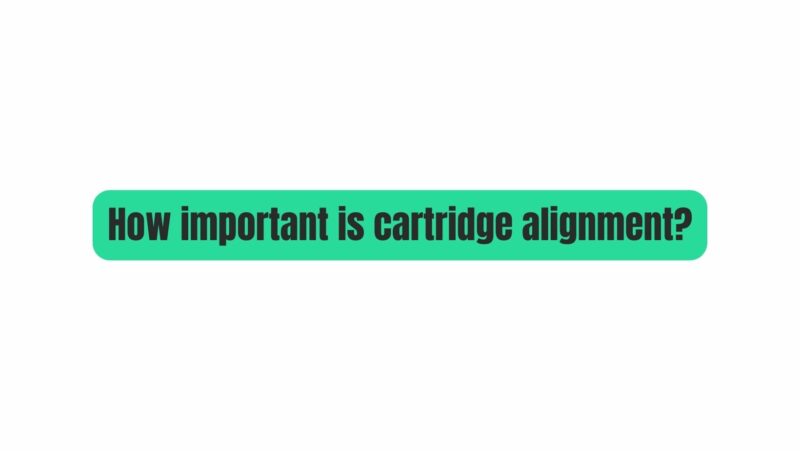In the world of vinyl record enthusiasts and audiophiles, achieving the highest possible sound quality is a never-ending quest. While turntables, tonearms, and cartridges all play crucial roles in this pursuit, one often-overlooked element is phono cartridge alignment. Precise cartridge alignment is the linchpin that ensures your vinyl records are played back with fidelity, accuracy, and minimal distortion. In this comprehensive guide, we will explore the pivotal role of cartridge alignment, its impact on sound quality, various alignment methods, and the step-by-step process to achieve optimal alignment.
I. The Crucial Role of Cartridge Alignment
1. Transducer of Musical Information: The phono cartridge is the component responsible for converting the mechanical vibrations stored in the grooves of vinyl records into electrical signals that can be amplified and translated into audible music. Accurate alignment ensures that this transduction process faithfully captures the recorded music. 2. Minimizing Tracking Errors: Proper alignment minimizes tracking errors, where the stylus deviates from the center of the groove. These errors can lead to distortion, mistracking, and premature wear on both the stylus and the record. 3. Preservation of Vinyl Records: By reducing tracking errors and minimizing wear and tear on the record grooves, correct cartridge alignment helps protect your precious vinyl collection and ensures its longevity.
II. The Sonic Consequences of Misalignment
Misaligned cartridges can result in various sonic issues, including:
1. Tracking Distortion: Misalignment can cause distortion, particularly in high-frequency passages, resulting in a harsh and fatiguing listening experience. 2. Inner Groove Distortion: Inaccurate alignment often impacts the inner grooves more severely, as the stylus encounters tighter and faster-moving grooves toward the center of the record. 3. Loss of Detail: Mistracking due to misalignment can lead to a loss of detail and nuance in the music, robbing the listener of the full sonic experience. 4. Premature Wear: Misaligned cartridges can exert uneven pressure on the record grooves, leading to accelerated stylus and record wear.
III. Alignment Methods: A Balancing Act
Several alignment methods are commonly used in the world of vinyl playback, each with its own philosophy and approach. The main alignment methods include:
1. Baerwald (Löfgren) Alignment: This widely adopted alignment method aims to minimize tracking error across the entire playing surface, offering a balanced compromise between various alignment factors. 2. Stevenson Alignment: The Stevenson alignment places a strong emphasis on minimizing distortion and phase error, particularly in the inner grooves of a record. It is favored by some audiophiles for its perceived improvement in sound quality. 3. Loefgren A and B Alignments: Variations of the Baerwald alignment, Loefgren A and B, offer different trade-offs between tracking error and distortion. They are designed to suit various playback scenarios and stylus geometries. 4. Other Alignment Methods: Some audiophiles and turntable enthusiasts explore less common alignment methods, such as the null-point alignment and the MintLP alignment, which prioritize specific aspects of playback performance.
IV. The Alignment Process: Step by Step
Achieving precise cartridge alignment is a meticulous process. Here’s a step-by-step guide to help you align your cartridge accurately:
1. Gather Your Tools: Ensure you have the necessary tools, including the appropriate alignment protractor, stylus force gauge, and cartridge screws. 2. Mount the Cartridge: Carefully mount the cartridge onto the headshell of your tonearm, ensuring it is securely fastened. 3. Set Stylus Force: Use the stylus force gauge to set the correct tracking force according to the manufacturer’s specifications for your cartridge. 4. Initial Alignment: Begin with a preliminary alignment based on the desired alignment method (e.g., Baerwald, Stevenson, etc.). Place the protractor on the platter, aligning it with the turntable spindle. 5. Align the Cartridge: Carefully adjust the cartridge’s position on the headshell following the alignment protractor’s guidelines. This step involves precise horizontal and vertical adjustments. 6. Fine-Tune Tracking Force: Double-check and fine-tune the stylus force to ensure it matches the recommended tracking force for your cartridge. 7. Check Overhang: Verify that the cartridge overhang is correctly set. Overhang is the distance from the spindle to the stylus tip and varies among tonearms. 8. Confirm Alignment: Double-check the alignment visually to ensure the stylus lines up precisely with the protractor’s grid or lines. 9. Final Checks: Play a test record to assess the sound quality and tracking performance. Listen for distortion, tracking errors, or mistracking issues. 10. Iterate if Necessary: If you encounter issues, don’t hesitate to revisit the alignment process and make minor adjustments until you achieve optimal sound quality.
V. Additional Considerations
1. Turntable Setup: Ensure your turntable is level, stable, and properly calibrated before beginning the alignment process. 2. Experimentation: Fine-tuning cartridge alignment can be an iterative process. Don’t be afraid to make minor adjustments and re-evaluate until you achieve the desired sound quality. 3. Professional Assistance: If you’re uncertain or uncomfortable with the alignment process, consider seeking assistance from a professional turntable technician.
VI. Conclusion
In conclusion, phono cartridge alignment is a fundamental aspect of vinyl playback that significantly impacts sound quality and overall listening enjoyment. The importance of achieving precise cartridge alignment cannot be overstated, as it ensures accurate tracking, minimizes distortion, and preserves your vinyl collection.
While the process of cartridge alignment may seem intricate, it is an essential skill for any vinyl enthusiast seeking to optimize their turntable setup. With the right tools, patience, and attention to detail, you can align your cartridge with precision, unlocking the full potential of your vinyl records and experiencing the rich, nuanced sound that vinyl playback can offer. Whether you’re a seasoned audiophile or a vinyl novice, mastering the art of cartridge alignment is a worthwhile endeavor on your journey toward audio perfection.

